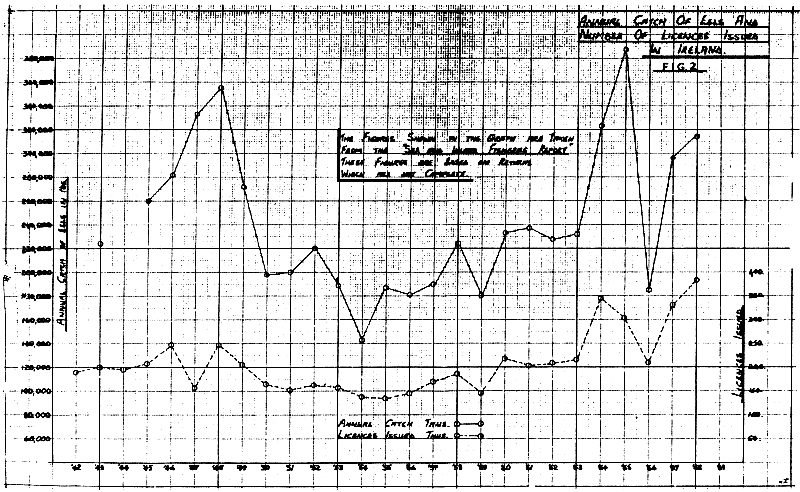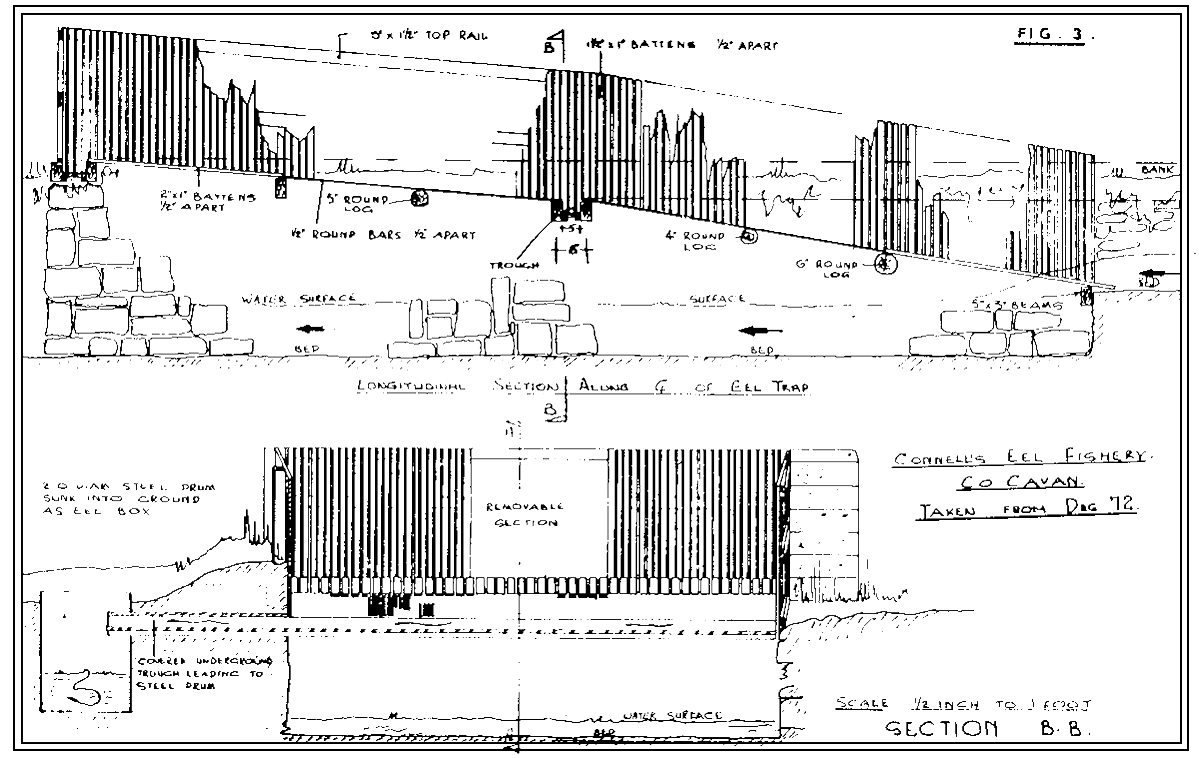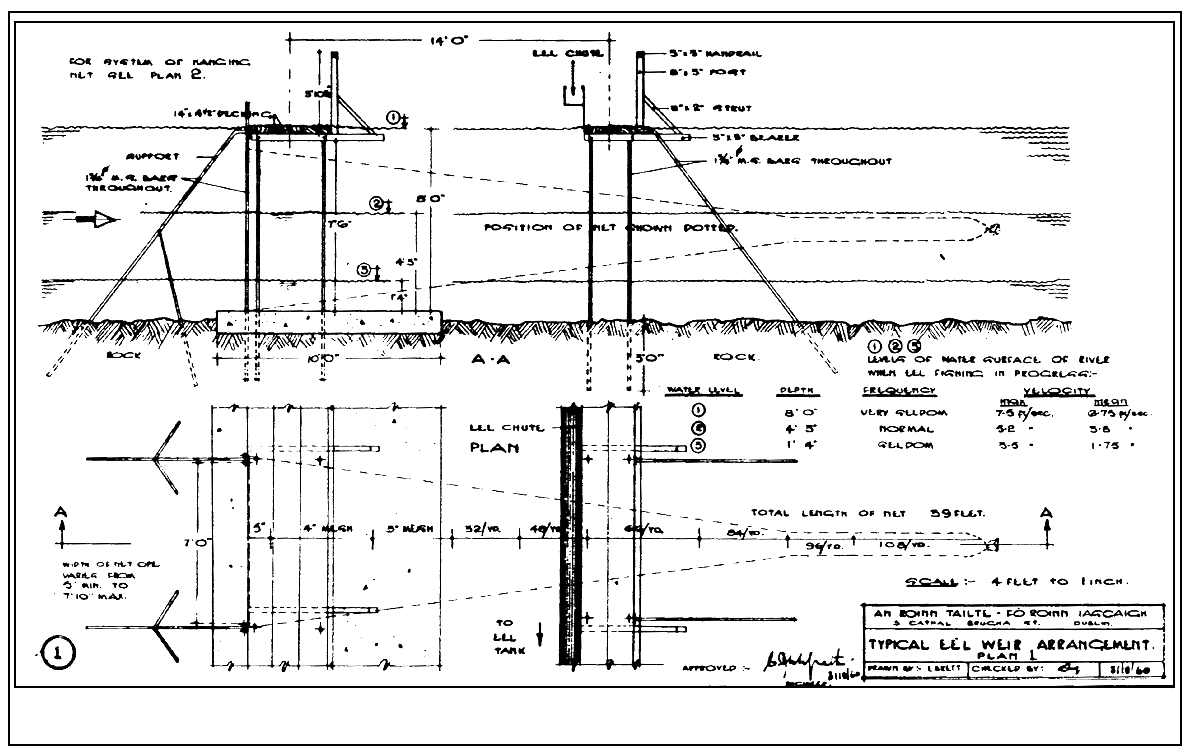by
C.J. McGrath
Inspector and Engineer
Department of Agriculture and Fisheries
Dublin 1, Ireland
Eel (Anguilla anguilla) fishing in Ireland is based, in the main, on the capture of the silver eels while migrating to the sea in the Autumn and early Winter of each year and, to a lesser extent, on the capture of yellow eels in lakes.
Eel fishing is not carried out as intensively in Ireland as it is in many other countries. There are 144 522 hectares of fresh water under the administration of the Department of Agriculture and Fisheries, Dublin, but not all the eel stocks in these are exploited and those that are exploited are not intensively so. The location of the principal eel fishing operations is shown in Figure 1.
In the 20-year period from 1963 to 1968, the annual catch of eels reported has ranged from as low as 65 metric tons in 1950 to a maximum of 176 metric tons in 1965. The actual variation in catch from year to year is illustrated in Figure 2.
While there are grounds for believing that the figures for total catch reported for each year are not accurate, nevertheless, all indications point to the discrepancy between the figures quoted and the true figures being not such as would cause any drastic change in the graph as plotted.
There are a number of explanations for the comparatively low level of eel production. It is not possible to exclude the possibility that the production of eels in Irish waters is less than in other countries. However, there are a number of contributory factors which tend to result in a low level of exploitation of the eel stocks available. Among these is the difficulty of conducting eel fishing operations by conventional methods in the flow conditions obtaining in typical Irish rivers. The run-off of the rivers is subject to great variations and very rapid changes can occur in the volume of flow in the river over a short period of time. This is particularly so at the time of year when silver eels are migrating to the sea.
In addition, most Irish rivers carry a considerable load of debris such as leaves from trees and weeds under such river flow conditions. These can very quickly block the conventional eel fishing devices and entail the expenditure of considerable effort to keep the eel nets and traps clear of accumulations of debris. This is essential particularly in the larger installations, to prevent the installations being blocked and washed away or alternatively, resulting in the flooding of adjoining lands.
Another important factor is that eel fishing activities in many places must be subordinate to the requirements of game fishing for salmon and trout, which provide an important source of revenue to the country from tourist anglers. Considerable attention is paid to safeguarding the requirements of the salmon and trout and the sport fishing activities based on their capture, and so eel fishing operations are subject to a number of restrictions in the interest of the game fish.
Considerations such as these militate against more intensive fishing for eels, especially in the large lakes where it is feared the employment of the large type fyke net with leader extending from the shore line would interfere with the movement of boats engaged in sport fishing. In addition, there is also apprehension in angling circles that these types of nets would capture large numbers of salmon and trout which, otherwise, would be available for anglers.
In recent years, experiments have been conducted with the so-called “Summer” fyke nets to ascertain whether these could be employed in Irish water without conflict with the other fishery interests. These experiments are proceeding and it is too soon yet to say what the final decision will be; however, early indications are that they are unlikely to harm other fish stocks. These nets are also being used to provide specimens for age determination and for the acquisition of information about feeding habits.
Among the methods which have been employed over the years for the capture of eels are:
Of these, long lines, eel grid traps and eel weirs are the most productive methods.
Long Lines
The practice followed in Ireland is very much the same as that employed in other countries and therefore particular mention of this method is not necessary in this report.
Eel Grid Traps
A typical installation of this kind is illustrated in Figure 3. The eels are sieved out of the river flow by the grid arrangements from which the only escape is either upstream back against the river flow or into a sunken trough from which a pipe leads to a tank from which the eels are unable to escape because it is fitted with a non-return valve.
The vertical grid on the downstream face of a number of these installations is hinged to the supporting cross beam so that in the event of the grating becoming clogged with debris, it will be forced open by the weight of the impounded water behind and thus allow it to escape, and thereby prevent the flooding of adjoining land or the destruction of the eel fishing installations.
Eel Weirs
The arrangement of a typical installation of this type is shown in Figures 4 and 5. These drawings are based on structures which are in operation. In this particular case, the foundation on which the structure rests is of rock, so that the supporting framework is not as strong as is required in other installations where weaker foundation conditions obtain.
In one installation of this type, comprising a row of 11 conical nets, a catch of 16 metric tons of eels in a fishing season has been possible. In another installation, in which provision has been made for 50 conical nets, a catch of 30 metric tons in a fishing season is possible.
Two typical eel nets which have been employed in Ireland in structures such as these, are made up as follows:
Eight ft of 280 meshes round, each 4 in, then tapering over a distance of 12 ft at 1¼ in mesh to 160 mesh round, each 7/8 in, and continuing for a further 12 ft. A valve 8 ft long, made up of 1¼ in mesh commences at the start of the taper in the main net and itself tapers to 30 mesh round, at 1¼ in, in a distance of 8 ft.
Another net arrangement is made of 265 mesh round, at 4 in mesh, extending for a distance of 6 ft 8 in, and then tapering at 1¼ in mesh to 180 mesh round. A valve likewise is fitted inside the taper which is also made up of 1¼ in mesh but tapering to 30 mesh round size.
Another more rudimentary type of eel net installation is shown in Figure 6.
There has been an increased interest in the development of eel fisheries in Ireland in recent years. Many individuals have built small eel fishing installations of the types described above.
The Electricity Supply Board of Ireland in particular has embarked on a major programme of development of the eel fisheries in the River Shannon, which is the largest river in Ireland. When this river was harnessed by the construction of a hydro-electric station to produce electricity, the entire fishing rights in the river system above a certain boundary line were vested in the Company by the State and it was charged with the responsibility of developing the fisheries in the waters entrusted to its care. Among the many steps taken by the Electricity Supply Board in discharge of this responsibility, has been the development of the eel fisheries in the river system. The Board has embarked on a programme of restocking the lakes in this system with elvers. These elvers have been captured in the lower reaches of the River Shannon as well as in other river systems (by permission of the Fishery Authority on an experimental basis) where eel fishing is not carried out and the elvers have been transported to the lakes and upper reaches of the River Shannon.
An ingenious elver trapping device has been devised by a member of the Board's Engineering staff, Mr. D. O'Leary. Details of this installation will be supplied in a separate paper to be presented to this Consultation and it is sufficient to make mention only of the development in this paper.
The storage of eels is not practised to a great extent in Ireland as most of the catch is exported as soon after capture as possible. The most important market for Irish eels at the present time is that at Billingsgate in London where eels can arrive alive usually within 24 hours of capture. Some provision is made for the storage of eels for a short period of time but, in general, these arrangements consist of wooden crates built on the river bed adjoining the place of capture or floating and attached to anchors. Provisions are made for the flow of water through the tanks so that the eels will be kept in a healthy condition. Special precautions have to be taken to ensure that the eels will not escape from the tanks and, in particular, that they will not damage themselves in endeavouring to force their way through openings in the tanks. It has been the experience that any opening greater than ¼ in diam. will encourage the eel to try and force its way out and usually the eels damage themselves, especially at the tail, and so die.
In recent years there has been a growing interest in the processing of eels before dispatch, particularly the hot-smoking of eels. A document was prepared to inform processors in Ireland on suitable methods of smoking eels. It is a record of the methods demonstrated by Mr. J. van Pel, a member of the technical staff of the Institute of Fishery Products, T.N.O. IJmuiden, The Netherlands, whose services were made available in 1962 by the courtesy of the Institute and its Director, Ir. J. van Mameren1.
However, the Irish public is not as interested in the consumption of smoked eel as are people in other countries and the majority of eels captured still continue to be exported live or deep frozen to other countries where the importers, for obvious reasons, prefer to purchase the eels and smoke them than to import the processed fish.
In an effort to overcome the problem posed by the clogging of eel traps and eel nets with leaves and other debris, efforts in recent years have been directed to the developing methods of eel fishing less likely to be affected by the presence of floating debris in the rivers. One line of investigation being followed is the employment of electricity to divert eels from the main river channel to a smaller and more easily maintained eel trap at one side. This work has not been successful as yet in the field, despite encouraging results obtained in laboratory experiments. The difficulty being experienced arises from the velocity of flow obtaining in the main river at the sites where the barriers are erected. Due to this velocity of flow, eels which are affected by the electric field and their swimming ability thereby impaired, tend to be drawn through the electric field by the river flow rather than diverted to one side.
Some details of the results obtained in investigations of the use of electricity for the capture of eels are contained in EIFAC OP3 “Application of Electricity to Freshwater Fishery Management and Development in Ireland” by C.J. McGrath et al. and FI 68/SC 1 – 3; 1 – 4 - “The use of electricity in the Exploitation of Eel Stocks” by P.J. Sharkey (see Appendix 24).

Fig. 1 Preliminary data on elvers and eel fisheries in Ireland

Fig. 2 Annual catch of eels and number of licences issued in Ireland.

Fig. 3 Connell's eel fishery. Co. Cavan

Fig. 4 Typical eel weir arrangement. Plan 1.

Fig. 5 Typical eel weir arrangement. Plan 2.

Fig. 6 Fisher's eel fishery. Co. Cavan.
1 Copies can be obtained from the author of this paper